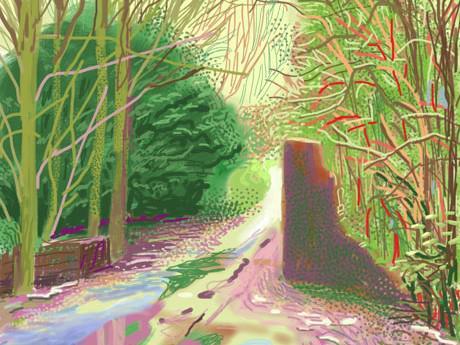
iPad drawing No 2 from David Hockney's The Arrival of Spring in Woldgate, East Yorkshire 2011
David Hockney is regarded by many as Britain’s greatest living artist. So, it is no surprise a major show of his new work has hugely excited the art world and the public. David Hockney: A Bigger Picture, which is comprised of over 150 landscapes, and runs at the Royal Academy of Arts from Saturday until April 9, has divided the art critics.
Many of the landscapes were painted outdoors and depict the countryside around Bridlington, the small Yorkshire seaside town where Bradford-born Hockney has lived for seven years. The exhibition includes 50 colourful drawings, created using an iPad and printed on to paper.
Absolutely stunning. Adrian Hamilton of The Independent hailed an “absolutely stunning exhibition” and praised Hockney’s “breathtaking ambition.” “It doesn’t represent a total revolution in landscape painting”, said Hamilton, “ but it does reveal a major artist at full pelt and bursting with creativity in his seventies.” The critic credited the Royal Academy, which commissioned the exhibition from the artist when they first became aware of his landscape work in Yorkshire after he produced his 50-canvas Bigger Trees near Warter in 2007, “have done him proud, giving the artist full space to sow his works, big and small, in profusion but also uncluttered and airy.”
There have been more advance ticket sales for Hockney’s new exhibition at the Royal Academy than there were for the gallery’s blockbuster Van Gogh exhibition in 2010, reported The Daily Telegraph.
A sort of slurry. Adrian Searle of The Guardian warned that Hockney’s “reinvention of himself as a full-blooded landscape artist is not without danger … he’s up against history.” Searle said that, as a landscape artist, Hockney “lacks the elan and notational elegance of, say, America’s Alex Katz, as well as the vision of Samuel Palmer and the wonderment of Stanley Spencer, never mind the degree of perspicacity shown by dozens (if not hundreds) of lesser-known landscape artists, many of whom line the walls of the Royal Academy summer shows. And we haven’t even got to the very great painters of nature: Courbet and Turner, Monet and Constable, Cézanne and Van Gogh.” Searle recognized that Hockney has always had an ability to capture a “kind of presentness” but, these days, he “still tries to do this but fails as often as he succeeds. Looking closely at his paintings of tunnels of trees overhanging a country track, I just get irritated by all the dibbling and dabbing, all that poking and flicking, the results of his attempts to vary the pace and the touch. What he actually lacks is touch itself. I don’t mind the coarseness of his smaller and larger painterly gestures, but they seem as affected as they are impetuous. It all becomes a sort of slurry. Large or small, in watercolour or in oils, the paintings seem to sag, their variety – bright celandines under a canopy of spring foliage, a carpet of fallen beech leaves tiger-striped by shadow – becoming a sort of sameness … all those splodges and patterns, smears and dapples and churnings get very wearying. I just can’t wait to get indoors and kick the gumboots off.”
So passé. Writing at The Daily Telegraph, Alastair Sooke lamented that “the simple truth is that the show is far too big. Like a sprawling oak in need of a tree surgeon, it required a stronger curator prepared to lop off the deadwood.” Besides the sheer size of the exhibition, Sooke was not turned on by Hockney’s reinvention as a landscape artist: “Perhaps it’s a generational thing, but I don’t understand paintings like these. Fresh, bright and perfectly delightful, they are much too polite and unthinkingly happy for my taste: if they offer a vision of arcadia, it is a mindless one. Moreover, they resemble the sorts of landscapes that we expect from amateur Sunday painters. Hockney is anything but that – yet whatever game he is playing here eludes me.” Sooke regretted that the “radical has come over all conservative” and took aim at the “irksome” iPad paintings: “Some people get excited because they were made using a piece of fashionable technology (a tablet computer with a touch screen). Yet the technique is surely immaterial – as Hockney says, an iPad is just another tool for an artist, like a brush. What’s important is how they look: competent, easy on the eye (like art for magazine covers), but flat as though drawn with felt-tip pen. Some of the earlier pictures in the sequence, featuring tumbledown brick walls and tree stumps, look like illustrations for horror fiction. The later ones, full of frothy blossom and unfurling buds, have a trite cheeriness. They would look wonderful on the walls of a hospital, but the prominence they are given here is baffling. They appear to ignore an entire century of modern art — a narrative, incidentally, with which Hockney is fully up to speed. Why would someone so clued up wilfully paint as though surrealism, colour-field abstraction, minimalism and all the rest hadn’t happened? These images are so passé they feel like a provocation. I don’t get it.”

